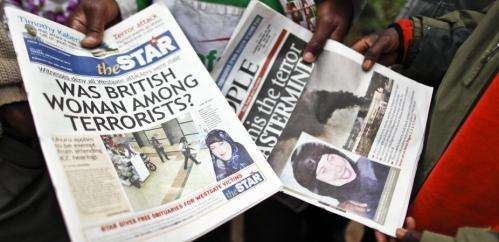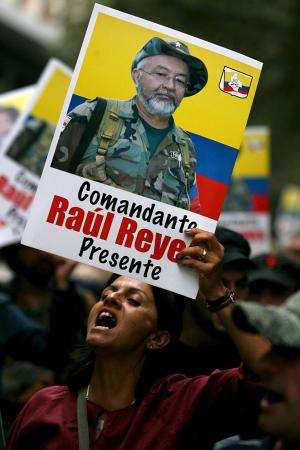'White Widow', 'Black Widow': Why do female terrorists perplex us?

While the Westgate terrorist siege in Kenya propelled terrorist group Al Shabaab and, to a lesser extent, the Muslim Youth Centre (MYC) back onto the global scene, the alleged involvement of Samantha Lewthwaite, the "White Widow", has seemingly shocked both media and audiences internationally.
A convert to Islam at the age 15, Lewthwaite married Germaine Lindsay in 2002. Born in Jamaica and also a convert to Islam, Lindsay is known for his role as one of four 7/7 London bombers. Currently suspected as a ringleader in the Westgate plot, Lewthwaite has suspected links to Al Shabaab and is wanted in Kenya over terrorism-linked charges.
While the shock of the involvement of a female terrorist has made headlines around the world, females engaging in acts of politically motivated violence is not a new, or rare, phenomenon. In fact, there is an array of examples internationally of acts carried out by females – notably including the assassination of former Indian prime minister Rajiv Gandhi by Tamil Tiger suicide bomber Thenmozhi "Gayatri" Rajaratnam in 1991.
Females are often utilised by terrorist organisations for specific functions. However, why females become terrorists is often overlooked and can differ from their male counterparts.
The 'Black Widows'
An example of where females are used prevalently in terrorist attacks are the "Black Widows" within Chechnya. The Black Widows are female suicide bombers generally of Chechen origin, who have lost husbands (though sometimes also sons and brothers) in the Chechen secession wars against Russia.
The first renowned Black Widow was Khava Barayeva, who blew herself up at a Russian military base in Chechnya in 2000. Black Widows were also involved in the 2002 siege of the Moscow Nord-Ost theatre by Chechen rebels, in which 130 hostages were killed.

Although the Black Widows are often considered to be an overall phenomenon rather than an organised group, an alert was issued to the Russian security forces in 2004 regarding a woman known as "Black Fatima", who was thought to be the principal recruiter of female suicide bombers within Russia. Some attacks have been carried by group calling itself the "Black Widows Brigade".
The most recent instance of a suicide attack by a Black Widow was in May this year in Dagestan.
The 'Mother of Believers'
One of the more controversial cases of the utilisation of women as terrorists was a previous tactic used by Ansar al Sunnah in Iraq. Known as the "Mother of Believers", Samira Jassim admitted to recruiting, indoctrinating and training women to carry out suicide attacks for the organisation, particularly in the Baghdad and Diyala provinces.
On her arrest, Jassim said she had recruited 80 female suicide bombers, 28 of whom went on to carry out attacks. She also admitted to taking advantage of these women and had some of them raped to shame them into conducting the suicide attacks. After the rape, Jassim told the women that the only way they could escape this shameful act was to act as a suicide bomber.
Though this type of manipulation of females is incredibly rare and not generally used by terrorist organisations and insurgencies, in this case it was used as a means to carry out an attack while avoiding detection.
Why do women commit acts of terror?
From a tactical perspective, there are a variety of different reasons why women are used in terrorist campaigns. If the terrorist organisation or insurgency's membership is depleted, women are often recruited into the movement to not only build up numbers, but also to fill tactical gaps. Women are often considered capable in achieving "surprise attacks", because they are least expected.
Particularly in relation to attacks on "soft targets", such as public gatherings, markets and ceremonies, women are often considered to be able to blend into the crowd and subsequently are able to avoid detection. However in some movements, such as the Revolutionary Armed Forces of Colombia (the FARC), women are considered the military and are put on the frontline.
Why women choose to become terrorists depends on the individual, the organisation, and the political goal or aim of the group. In the case of some females – such as the Black Widows – it is to avenge the loss of a loved one such as a husband, brother, son or cousin. Sometimes the act of terrorism is also conducted to redeem the family name.
In this respect, women can become involved in terrorism for personal, rather than ideological, reasons. However, in the case of some movements like the FARC, female involvement is seen as a means of evening out patriarchy, and giving women a sense of empowerment, participation and accomplishment.
It is not surprising that significant attention has been given to the alleged involvement of the "White Widow", because the idea of a female terrorist is unexpected and quite confronting for some. However, it is also highly unlikely this will be the last time a female terrorist is propelled onto the scene.
Source: The Conversation
This story is published courtesy of The Conversation (under Creative Commons-Attribution/No derivatives).
![]()














